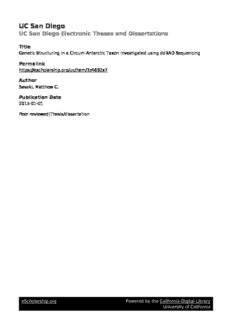
Genetic Structuring in a Circum-Antarctic Taxon Investigated using ddRAD Sequencing PDF
Preview Genetic Structuring in a Circum-Antarctic Taxon Investigated using ddRAD Sequencing
UC San Diego UC San Diego Electronic Theses and Dissertations Title Genetic Structuring in a Circum-Antarctic Taxon Investigated using ddRAD Sequencing Permalink https://escholarship.org/uc/item/3z4692x7 Author Sasaki, Matthew C. Publication Date 2015 Peer reviewed|Thesis/dissertation eScholarship.org Powered by the California Digital Library University of California ! UNIVERSITY OF CALIFORNIA, SAN DIEGO Genetic Structuring in a Circum-Antarctic Taxon Investigated using ddRAD Sequencing A thesis submitted in partial satisfaction of the requirements for the degree of Masters of Science in Biology by Matthew C. Sasaki Committee in charge: Professor Ronald Burton, Chair Professor Jonathan Shurin, Co-Chair Professor Scott Rifkin 2015 ! i !! ! ! ii ! ! The thesis of Matthew C. Sasaki is approved, and it is acceptable in quality and form for publication on microfilm and electronically: ______________________________________________________________ ______________________________________________________________ Co-Chair ______________________________________________________________ Chair University of California, San Diego 2015 ! iii ! ! DEDICATION For my parents. Thank you for the unconditional love and support you have always shown. I am who I am today because of you. Mom, thank you for instilling in me a burning desire to understand the natural world, and for all of the advice (especially when I didn’t even know I needed it). Dad, thank you for always being there to talk some sense into me, and for teaching me to stick to my morals and ethics. For Ruben. Thank you for putting up with all the late nights and weekends in lab. I could not have made it through this without you. On to the next big adventure. And for the members of Gen 11. Thank you for always being there for me. You all have profoundly impacted my life for the better, and I look forward to a lifetime of friendship. #oneonelove ! iv ! ! TABLE OF CONTENTS Signature Page…………………………………………………………………. iii Dedication ..…………………………………………………………………….. iv Table of Contents…………………..……………………………………..…….. v List of Figures………………………..……………………………..…………… vi List of Tables …………………………………………………...……………… vii Acknowledgements……………………………………………………..……… viii Abstract of the thesis…………..………..………………………….…………… x Introduction……………………………………………………………………….. 1 Methods………………………………….……………………………………… 19 Results……………………………………….………………………………….. 25 Discussion…………………………………….………………………………… 30 References……………………………………..……………………………….. 35 ! v !! ! LIST OF FIGURES Figure 1 : Map of sampling localities. Colored circles indicate populations sampled for this study…………….………………………………………………. 20 Figure 2 : Plot of genetic distance (F ) by geographic distance…………….. 28 st Figure 3 : Group membership coefficients for 69 Glabraster antarctica individuals. Each individual is represented by one bar. Shading represents the probability of membership to each of the four inferred populations. Individuals are ordered by collection site ………………………..………………29 Figure 4 : Maximum likelihood network calculated in RAxML for the four populations of Glabraster antarctica ……….………………………………..…. 30 ! vi ! ! LIST OF TABLES Table 1 : Pairwise Fst values among populations of Glabraster antarctica. P < 0.001 for all comparisons ……………………....…………………………… 26 Table 2 : Observed Heterozygosity, with associated variance and standard error, as calculated in the Stacks pipeline for the filtered RAD data set ……………………………………………………………………………. 26 Table 3 : Genetic diversity across loci calculated in ARLSUMSTAT for the four popualtions of Glabraster antarctica…………………….………….…..…. 27 ! vii ! ! ACKNOWLDEGEMENTS I would first like to thank Dr. Ronald Burton for the many opportunities he provided me in his lab. He has provided constant support throughout each of my projects, and his advice on each undertaking in the lab, coursework, and life in general has been invaluable. I would also like to acknowledge Dr. Shurin and Dr. Rifkin, as the co- chair and third committee member, respectively, for their part in the completion of my degree. Their time and energy put into this project is much appreciated. I would also like to thank Dr. Greg Rouse for the opportunity to work on this project, for providing valuable samples for me to use, and for his assistance, advice, and discussion throughout the process. I would also like to thank Jose Carvajal for his patient assistance in obtaining said samples. And finally, it would be unforgivable to end this section without thanking the other members of the Burton Lab. Without the assistance of Lani Gleason, Tessa Pierce, and Josh Stewart, this project would not have happened. Thank you for putting up with my endless stream of questions. While not directly involved in this project I would also like to thank Ricardo Pereira. His mentorship during my undergraduate research is the reason I am here today. Our conversations have proved critical in my development as an independent scientist. And to Lori. I’m so glad I had someone to go through this process with. Without you to keep things “interesting”, this year likely would have been much more difficult, and definitely would have been much less enjoyable. ! viii ! ! There are many people, without whom I could not have completed this project, that I have not mentioned above. Nonetheless, your time and energy has been of immense importance to me, and I will be forever grateful. ! ix !
Description: